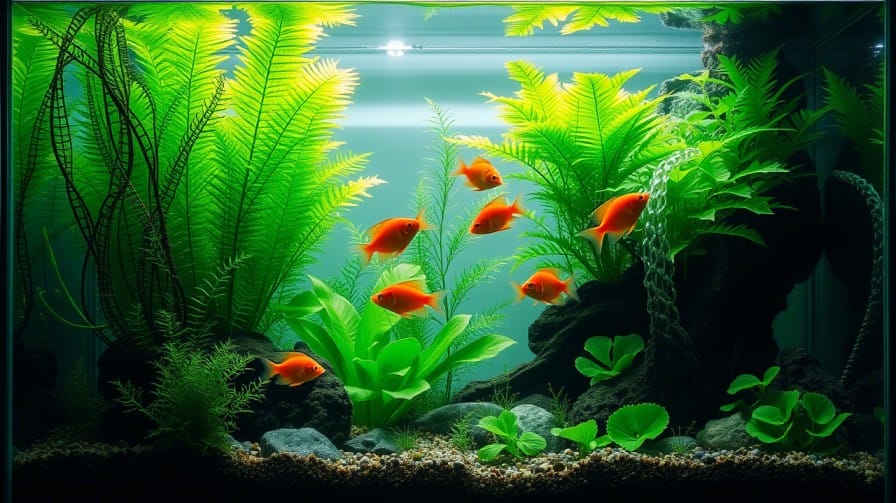
Introduction – Understanding Aquarium Anchor Worms and Why They’re a Problem
Aquarium anchor worms (Lernaea spp.), despite their name, are not worms but parasitic crustaceans that pose a significant threat to freshwater fish. These copepods embed their anchor-shaped heads into a fish’s skin, feeding on blood and tissues, which leads to irritation, inflammation, and potential secondary bacterial infections. Commonly found on koi, goldfish, and other freshwater species, anchor worms are particularly problematic in ponds and aquariums where new fish or plants are introduced without proper quarantine. The visible “worm” is actually the female’s reproductive structure, which releases eggs into the water, perpetuating the infestation cycle.
Early detection and treatment are critical to prevent severe health issues in fish. This comprehensive guide provides beginner and intermediate aquarium hobbyists with science-backed, practical steps to identify, treat, and prevent anchor worm infestations, ensuring a healthy tank environment.
How to Identify Anchor Worms in Your Aquarium
Prompt identification of anchor worms can significantly improve treatment outcomes. Here are the key signs and symptoms to watch for:
- Visible Parasites: Anchor worms appear as small, white-green or red threads protruding from the fish’s skin, often behind pectoral or dorsal fins, or even in the mouth, resembling “baleen” in severe cases (The Spruce Pets).
- Inflamed Skin: Red, inflamed spots or bloody patches at attachment sites, sometimes with fibrosis or hemorrhage if worms detach.
- Behavioral Changes: Infected fish may rub or scrape against tank objects, such as rocks or decorations, in an attempt to dislodge the parasites.
- Lethargy and Appetite Loss: Fish may become less active, lose appetite, or show signs of stress as the infestation progresses.
Anchor worms are macroscopic, meaning they’re visible to the naked eye, but they can be mistaken for other parasites like fish lice, which are flatter and disc-shaped. Regular inspection, especially after introducing new fish or plants, is essential. For visual reference, look for images showing thread-like structures on fish skin, often with egg sacs attached.
Read More: how to treat cloudy eyes in fish guide
Anchor Worm Symptoms Checklist
| Symptom | Description |
|---|---|
| Visible Threads | White-green or red threads protruding from skin, often with egg sacs. |
| Red Spots | Inflamed or bloody areas at attachment sites. |
| Rubbing Behavior | Fish scraping against objects due to irritation. |
| Lethargy | Reduced activity or sluggishness. |
| Loss of Appetite | Fish refusing food or eating less. |

Step-by-Step Treatment Guide
Treating anchor worms requires a multi-faceted approach to eliminate both adult parasites and their free-swimming juvenile stages. Follow these steps for effective treatment:
- Manual Removal:
- For medium to large fish (e.g., goldfish or koi over 5–6 inches), carefully remove visible anchor worms using tweezers. Hold the fish briefly out of water, grasp the parasite close to the skin, and pull gently but firmly to extract the entire worm, including the embedded head.
- Place the fish back in water every few seconds to allow it to breathe. After removal, apply a topical antibiotic ointment to the wound to prevent infection.
- Note: Manual removal is not recommended for small or delicate fish like bettas, as it can be too stressful.
- Chemical Treatments:
- Use aquarium-safe medications designed for parasitic crustaceans. Effective options include:
- Cyromazine: Found in Microbe-Lift Lice and Anchor Worm Treatment, safe for most fish and invertebrates.
- Diflubenzuron: Found in Dimilin or Jungle Labs Anchors Away, highly effective but may harm invertebrates.
- Potassium Permanganate: Used as a 15–30 minute bath in a light pink solution (1:10,000 dilution).
- Follow the manufacturer’s dosage instructions precisely, as overuse can harm fish or tank ecosystems.
- Use aquarium-safe medications designed for parasitic crustaceans. Effective options include:
- Tank-Wide Treatment:
- Juvenile anchor worms are free-swimming and can reinfect fish if not eliminated. Treat the entire tank with the chosen medication, repeating doses as directed (often weekly for 2–3 weeks).
- UV sterilization can kill free-swimming juveniles by removing substrate and decor and running water through a UV filter.
- Perform 25–30% water changes between treatments to maintain water quality and remove parasite eggs or larvae.
- Monitor for Secondary Infections:
- Attachment sites may develop bacterial infections, indicated by redness, swelling, or pus. Consult a veterinarian for antibiotics if needed, as over-the-counter antibiotics are not recommended.
- Maintain excellent water quality to support fish recovery and prevent infections.
- Sanitize the Tank:
- After treatment, thoroughly clean the tank, including substrate, decorations, and filters, to remove any remaining eggs or larvae. Disinfect with aquarium-safe solutions if necessary.
Anchor Worm Treatment Options
| Product/Treatment | Active Ingredient | Application Method | Effectiveness | Notes |
|---|---|---|---|---|
| Microbe-Lift Lice and Anchor Worm | Cyromazine | Add to tank water | High | Safe for most fish and invertebrates |
| Dimilin | Diflubenzuron | Add to tank water | High | May affect shrimp, snails |
| Potassium Permanganate | Potassium Permanganate | 15–30 min bath | Moderate | Harsh; use with caution, avoid overuse |
| Salt Bath | Sodium Chloride | 10–15 min bath or tank | Low-Moderate | Best for prevention or mild cases |
Preventive Measures to Stop Future Infestations
Preventing anchor worms is far easier than treating an infestation. Implement these strategies to keep your aquarium parasite-free:
- Quarantine New Fish:
- Isolate all new fish in a separate quarantine tank for 2–4 weeks. Monitor for signs of anchor worms or other diseases before introducing them to the main tank (Horizone Fish Foods).
- Inspect New Fish and Plants:
- Visually check new fish for thread-like parasites or skin tags. Inspect live plants for eggs, as they can carry anchor worm larvae. Consider using tissue-cultured plants grown in sterile conditions to avoid parasites (Build Your Aquarium).
- Buy from Reputable Sources:
- Purchase fish and plants from trusted suppliers known for maintaining parasite-free stock. Avoid buying from sources with visible infestations.
- Maintain Optimal Water Conditions:
- Regularly test water parameters (pH, ammonia, nitrite, nitrate) and perform 10–20% water changes weekly to keep water clean and reduce fish stress (The Spruce Pets).
- Avoid Overcrowding:
- Overcrowded tanks increase stress and disease transmission. Ensure your tank has adequate space for all inhabitants.
Anchor Worm Prevention Strategies
| Prevention Method | Description |
|---|---|
| Quarantine New Fish | Isolate new fish for 2–4 weeks to monitor for parasites. |
| Inspect New Additions | Check fish and plants for visible worms or eggs before adding to tank. |
| Buy from Reputable Sources | Choose suppliers with high health and hygiene standards. |
| Maintain Water Quality | Regular water changes and parameter testing to keep fish stress-free. |
| Avoid Overcrowding | Ensure adequate tank space to reduce disease transmission. |
Safe and Effective Products for Anchor Worm Removal
Selecting the right treatment product is crucial for safely eliminating anchor worms. The table above (Table 2) compares popular options. Here are additional considerations:
- Microbe-Lift Lice and Anchor Worm Treatment: Highly effective and widely praised for quick results, often within a week (Amazon Reviews). Safe for most tank inhabitants.
- Dimilin: Effective for severe infestations but requires caution due to potential impact on invertebrates.
- Potassium Permanganate: Best for baths rather than tank-wide treatment due to its potency. Use only in controlled conditions.
- Salt Baths: Useful for mild cases or as a preventive measure, but less effective against heavy infestations.
Always read product labels and consult with a veterinarian if you’re unsure about compatibility with your tank’s ecosystem. For purchasing, check trusted retailers like Amazon or local aquarium stores.
Call to Action: Buy recommended anchor worm treatments online or join our aquarium enthusiasts’ community for more tips!
FAQs
Can anchor worms live without a host?
Adult female anchor worms require a fish host to attach and feed, but juvenile stages (nauplii and copepodids) are free-swimming and can survive in the water until they find a host.
Is it safe to use organophosphates with invertebrates?
Organophosphates, such as trichlorfon, can be toxic to invertebrates like shrimp and snails. Use alternatives like cyromazine or remove invertebrates during treatment.
How long does it take to get rid of anchor worms?
Treatment duration varies but typically takes 2–8 weeks to eliminate all parasite stages, depending on the infestation severity and treatment consistency.
Do anchor worms affect humans or other pets?
No, anchor worms are specific to fish and do not infect humans or other animals.
What fish are most susceptible to anchor worms?
Koi, goldfish, and other pond fish are particularly prone, but any freshwater fish can be affected, especially in warmer water (26–28°C).
How do anchor worms spread?
Anchor worms spread through infected fish, contaminated water, or plants carrying eggs or larvae. Quarantine and inspection prevent transmission.
Can anchor worms be eradicated completely?
Yes, with diligent treatment (manual removal, chemical treatments, and tank sanitation) and preventive measures, anchor worms can be fully eradicated.
Expert Verdict – Best Practices for Healthy Fish and a Clean Tank
To maintain a thriving aquarium free from anchor worms and other parasites, follow these best practices:
- Vigilant Monitoring: Regularly inspect fish for signs of parasites or unusual behavior.
- Strict Quarantine: Quarantine all new fish and plants for at least 2–4 weeks to prevent introducing parasites.
- Optimal Tank Maintenance: Perform weekly water changes, test water parameters, and clean filters to keep the tank environment healthy.
- Stay Informed: Join aquarium communities or consult resources like The Spruce Pets to stay updated on fish health.
Call to Action: Download our free Anchor Worm Prevention Checklist to keep your tank parasite-free!
Recent Updates – New Treatments or Methods in 2025
As of 2025, the most effective treatments for anchor worms remain manual removal combined with chemical treatments like cyromazine (e.g., Microbe-Lift) or diflubenzuron (e.g., Dimilin). No significant new treatments have emerged, but ongoing research in aquaculture may introduce safer or more targeted solutions. Hobbyists should monitor reputable sources and forums, such as Aquarium Co-Op, for the latest developments.


